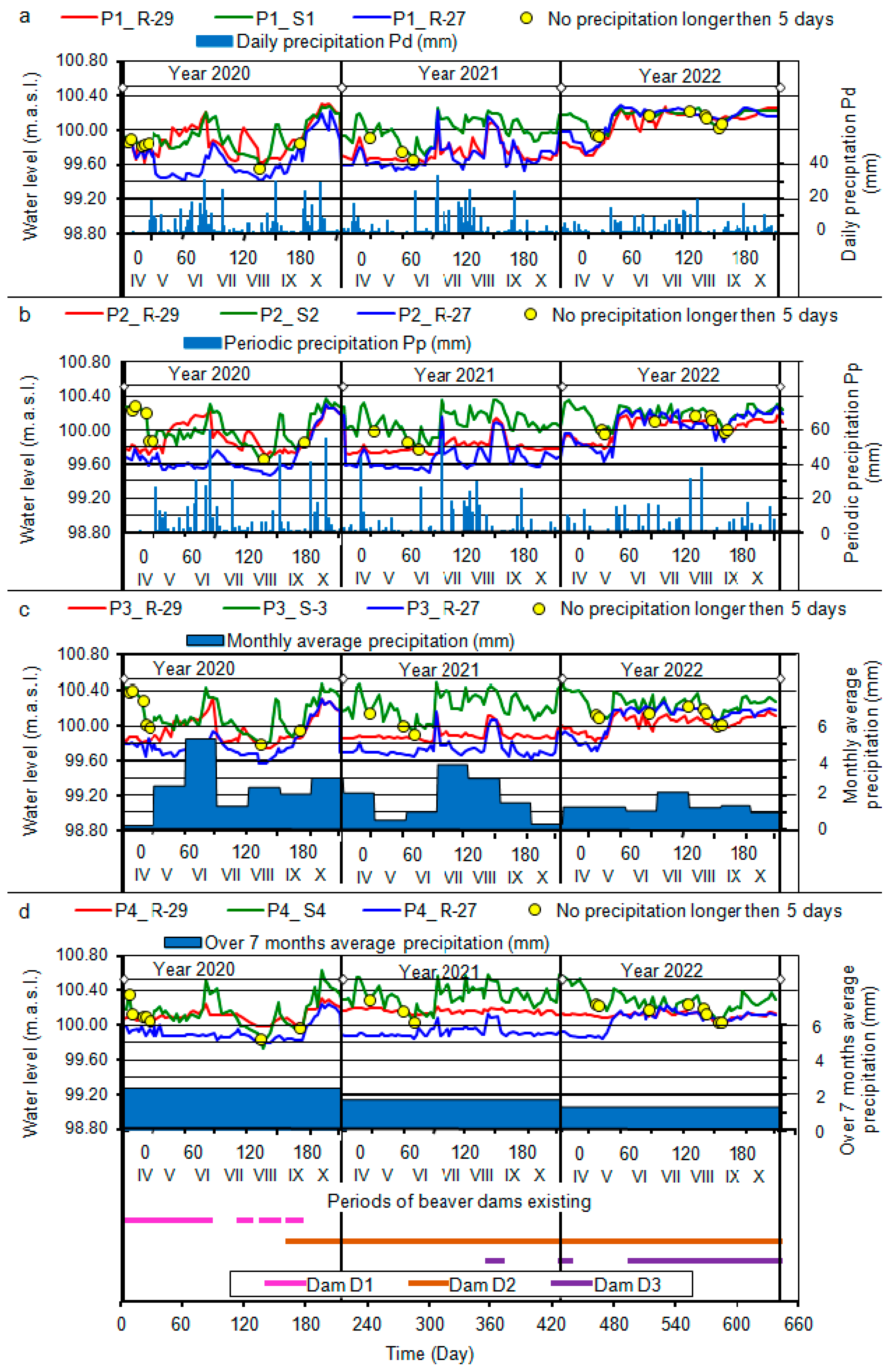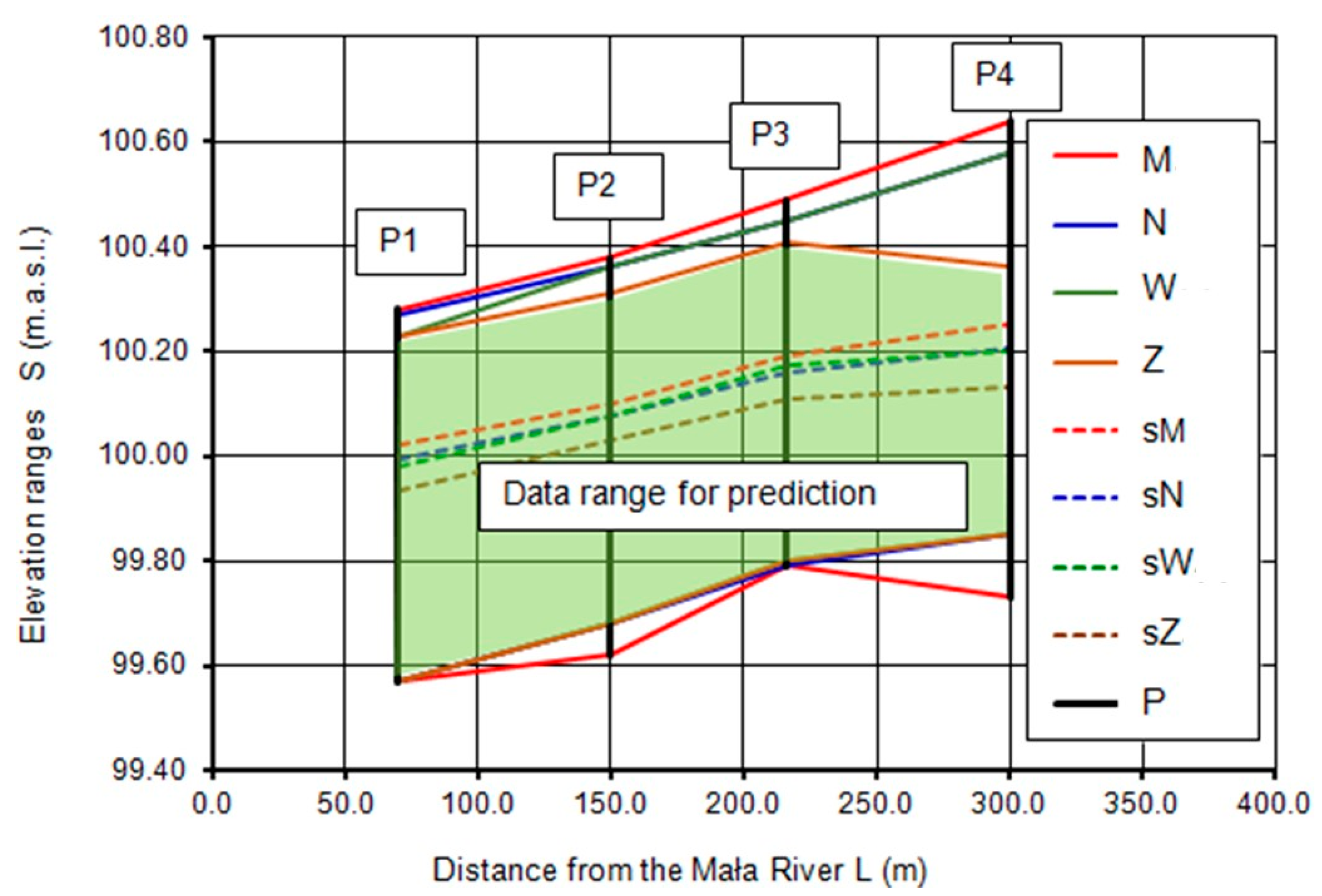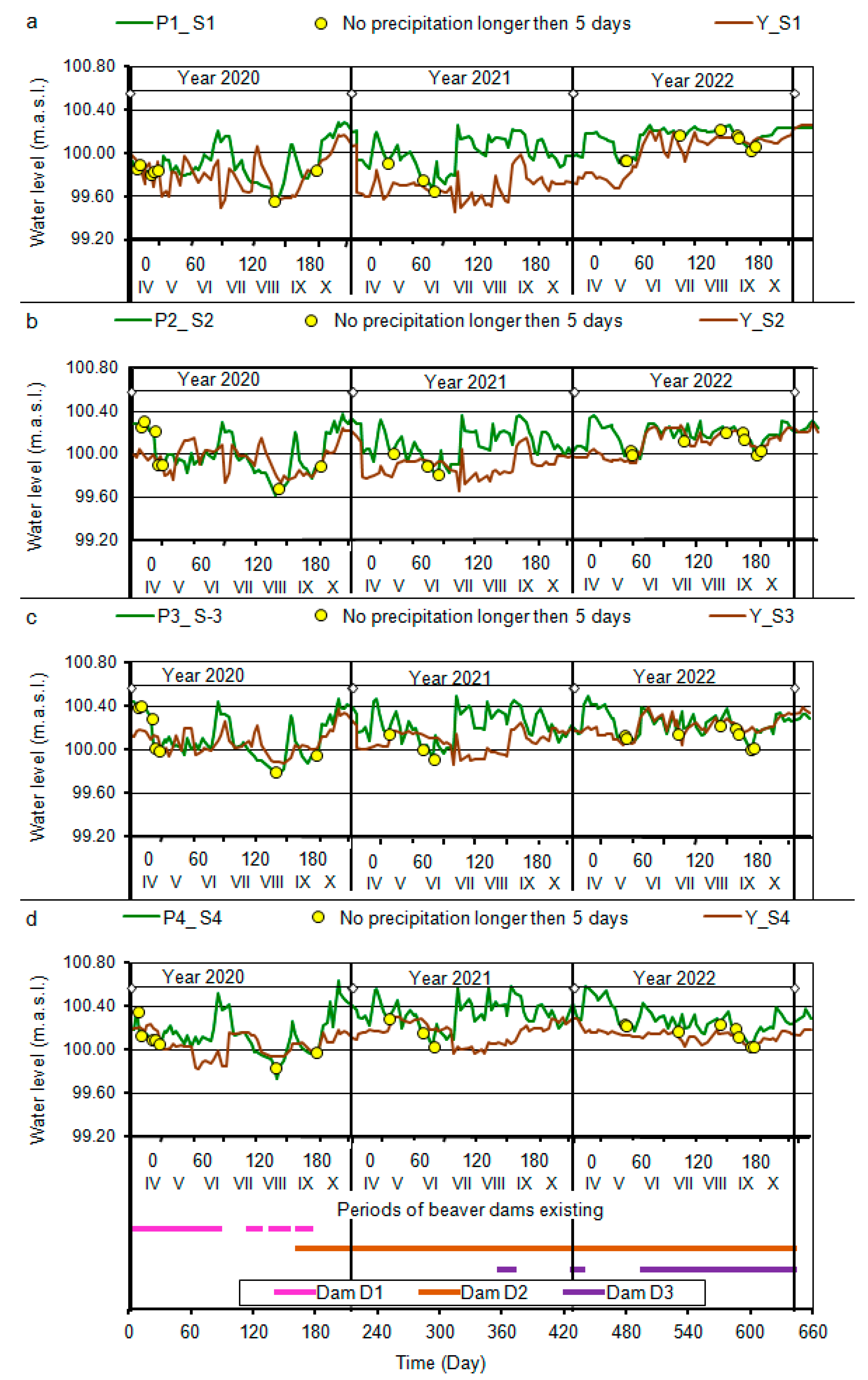The Impact of Beaver Dams on the Dynamic of Groundwater Levels at Łąki Soleckie
Abstract
1. Introduction
2. Materials and Methods
2.1. Research Facility
2.2. Research Methodology
2.3. Surface Water Levels
2.4. Precipitation and Beaver Activity
2.5. Groundwater Levels
2.6. Predictive Model
3. Results and Discussion
3.1. Surface Water Levels
3.2. Precipitation and Beaver Activity
3.3. Groundwater Levels
3.4. Predictive Model
4. Conclusions
- The water resources of the Mała River and adjacent ditches were closely related to atmospheric precipitation and the activity of beavers in the analyzed fragment of the drainage system. In 2020, with the highest sum of seven-month precipitation Pm7 = 524.2 mm, beaver activity was determined to be the lowest. In that year, beavers built and maintained a single dam in location D1. The average activity was defined in 2021 with a precipitation sum of Pm7 = 385.5 mm. In that year, beavers moved the dam to location D2 and began building another dam at location D3. The highest activity was observed in 2022 with the lowest precipitation sum of Pm7 = 298.2 mm. In 2022, beavers exploited two dams, namely D2 and D3, maintaining the highest water retention levels (Figure 2).
- By employing the data standardization method, five significant variables describing the impact of beaver activity on groundwater conditions in the study area were obtained. These variables belong to three groups: ditches, cross-sections, and precipitation. In the ditches group, two variables were identified: X1R-29 (m.a.s.l.), the water level in ditch R-29, and X2R-27 (m.a.s.l.), the water level in ditch R-27, whose temporal variability is shown in Figure 2. The cross-sections group is represented by two parameters: X3L (m), the distance of cross-sections from the Mała River according to Figure 1, and X4k (m·s−1), the filtration coefficient of the active layer of peat soil (kt = 5.2 × 10−6 m·s−1) and mineral soil (kp = 3.0 × 10−4 m·s−1). In the precipitation group, one variable was isolated: Pm (mm), the monthly sum of precipitation according to Table 1.
- The most significant impact on changes in groundwater levels was exerted by water levels in ditches directly adjacent to the study area. Adding successive variables to the linear prediction model increased the coefficient of determination, which, in the final verification stage, reached the value R2(1–5) = 0.698, with a simultaneous reduction in the standard error of estimation to the value sY(1–5) = 0.119 m (Figure 5).
- The groundwater table elevations in the middle of the study area depended on the water levels in ditches, the distance of cross-sections from the river, the soil filtration coefficient, and monthly rainfall sums affecting beaver activity. All the specified i = 5 predictors showed a significant impact on the final model outcome. Model verification on the training set Z = 72 (points in Figure 8) and the base set M = 720 (lines in Figure 8) demonstrated the stability of the developed model to the direct impact of rainfall. The indicated predictor X5Pm effectively describes the influence of rainfall on seasonal beaver activity.
Author Contributions
Funding
Institutional Review Board Statement
Informed Consent Statement
Data Availability Statement
Conflicts of Interest
References
- Sojka, M.; Kozłowski, M.; Stasik, R.; Napierała, M.; Kęsicka, B.; Wróżyński, R.; Jaskuła, J.; Liberacki, D.; Bykowski, J. Sustainable water management in agriculture—The impact of drainage water management on groundwater table dynamics and subsurface outflow. Sustainability 2019, 11, 4201. [Google Scholar] [CrossRef]
- Crawford, J.C.; Liu, Z.; Nelson, T.A.; Nielsen, C.K.; Bloomquist, C.K. Microsatellite analysis of mating and kinship in beavers (Castor canadensis). J. Mammal. 2008, 89, 575–581. [Google Scholar] [CrossRef]
- Boczoń, A.; Wróbel, M.; Syniaiev, V. The impact of beaver ponds on water resources in the catchment area in the Browsk Forest District—A case study. For. Res. Pap. 2009, 70, 363–371. [Google Scholar] [CrossRef][Green Version]
- Pietrek, A.G.; Escobar, J.M.; Fasola, L.; Roesler, I.; Schiavini, A. Why invasive Patagonian beavers thrive in unlikely habitats: A demographic perspective. J. Mammal. 2016, 98, 283–292. [Google Scholar] [CrossRef]
- Jones, B.M.; Tape, K.D.; Clark, J.A.; Nitze, I.; Grosse, G.; Disbrow, J. Increase in beaver dams controls surface water and thermokarst dynamics in an Arctic tundra region, Baldwin Peninsula, northwestern Alaska. Environ. Res. Lett. 2020, 15, 075005. [Google Scholar] [CrossRef]
- Wróbel, M. Population of Eurasian beaver (Castor fiber) in Europe. Glob. Ecol. Conserv. 2020, 23, e01046. [Google Scholar] [CrossRef]
- Brazier, R.E.; Puttock, A.; Graham, H.A.; Auster, R.E.; Davies, K.H.; Brown, C.M.L. Beaver: Nature’s ecosystem engineers. WIREs Water 2021, 8, e1494. [Google Scholar] [CrossRef] [PubMed]
- Naiman, R.J.; Johnston, C.A.; Kelley, J.C. Alteration of North American Streams by Beaver. BioScience 1988, 38, 753–762. [Google Scholar] [CrossRef]
- Tape, K.D.; Jones, B.M.; Arp, C.D.; Nitze, I.; Grosse, G. Tundra be dammed: Beaver colonization of the Arctic. Glob. Chang. Biol. 2018, 24, 4478–4488. [Google Scholar] [CrossRef]
- Połeć, K.; Grzywna, A.; Tarkowska-Kukuryk, M.; Bronowicka-Mielniczuk, U. Changes in the ecological status of rivers caused by the functioning of natural barriers. Water 2022, 14, 1522. [Google Scholar] [CrossRef]
- Piętka, S.; Misiukiewicz, W. Impact of European Beaver (Castor fiber L.) on vegetation diversity in protected area river valleys. Conservation 2022, 2, 613–626. [Google Scholar] [CrossRef]
- Orazi, V.; Hagge, J.; Gossner, M.M.; Müller, J.; Heurich, M. A biodiversity boost from the Eurasian Beaver (Castor fiber) in Germany’s oldest national park. Front. Ecol. Evol. 2022, 10, 873307. [Google Scholar] [CrossRef]
- Stefen, C.; Habersetzer, J.; Witzel, U. Biomechanical aspects of incisor action of beavers (Castor fiber L.). J. Mammal. 2016, 97, 619–630. [Google Scholar] [CrossRef]
- Karran, D.J.; Westbrook, C.J.; Wheaton, J.M.; Johnston, C.A.; Bedard-Haughn, A. Rapid surface-water volume estimations in beaver ponds. Hydrol. Earth Syst. Sci. 2017, 21, 1039–1050. [Google Scholar] [CrossRef]
- Ilnicki, P. Mit Stepowienia Wielkopolski w Świetle Wieloletnich Badań Obiegu Wody = Myth of the Steppe Forming Process in the Wielkopolska Region from the Viewpoint of Long Investigations of Water Circulation; Wydawnictwo Uniwersytetu Przyrodniczego: Poznań, Poland, 2012. [Google Scholar]
- Oleszczuk, R.; Jadczyszyn, J.; Gnatowski, T.; Brandyk, A. Variation of moisture and soil water retention in a lowland area of central Poland—Solec site case study. Atmosphere 2022, 13, 1372. [Google Scholar] [CrossRef]
- Somorowska, U. Amplified signals of soil moisture and evaporative stresses across Poland in the twenty-first century. Sci. Total Environ. 2022, 812, 151465. [Google Scholar] [CrossRef] [PubMed]
- Gamborg, C.; Sandøe, P. Beavers and Biodiversity: The Ethics of Ecological Restoration. In Philosophy and Biodiversity; Okksanen, M., Ed.; Cambridge University Press: New York, NY, USA, 2004. [Google Scholar] [CrossRef]
- Collen, P.; Gibson, R.J. The general ecology of beavers (Castor spp.), as related to their influence on stream ecosystems and riparian habitats, and the subsequent effects on fish—A review. Rev. Fish Biol. Fish. 2000, 10, 439–461. [Google Scholar] [CrossRef]
- Johnston, C.; Windels, S. Using beaver works to estimate colony activity in boreal landscapes. J. Wildl. Manag. 2015, 79, 1072–1080. [Google Scholar] [CrossRef]
- Hodkinson, I. Energy flow and organic matter decomposition in an abandoned beaver pond ecosystem. Oecologia 1975, 21, 131–139. [Google Scholar] [CrossRef]
- Ulloa, E.; Anderson, C.; Ardón, M.; Murcia, S.; Valenzuela, A. Organic matter characterization and decomposition dynamics in sub-Antarctic streams impacted by invasive beavers. Lat. Am. J. Aquat. Res. 2017, 40, 881–892. [Google Scholar] [CrossRef]
- Brandyk, A.; Kaca, E.; Oleszczuk, R.; Urbański, J.; Jadczyszyn, J. Conceptual model of drainage-sub irrigation system functioning-first results from a case study of a lowland valley area in central Poland. Sustainability 2020, 13, 107. [Google Scholar] [CrossRef]
- Čiuldienė, D.; Vigricas, E.; Belova, O.; Aleinikovas, M.; Armolaitis, K. The effect of beaver dams on organic carbon, nutrients and methyl mercury distribution in impounded waterbodies. Wildl. Biol. 2020, 2020, 1–8. [Google Scholar] [CrossRef]
- Darzi, A.; Ejlali, F.; Ahmadi, M.; Najfi, G.H. The suitability of controlled drainage and subirrigation in paddy fields. Pak. J. Biol. Sci. 2007, 10, 492–497. [Google Scholar] [CrossRef][Green Version]
- Szejba, D.; Bajkowski, S. Determination of tile drain discharge under variable hydraulic conditions. Water 2019, 11, 120. [Google Scholar] [CrossRef]
- Bajkowski, S.; Urbański, J.; Oleszczuk, R.; Siwicki, P.; Brandyk, A.; Popek, Z. Modular regulators of water level in ditches of subirrigation systems. Sustainability 2022, 14, 4103. [Google Scholar] [CrossRef]
- Hämmerling, M.; Kałuża, T.; Zawadzki, P.; Zaborowski, S.; Sojka, M.; Liberacki, D.; Ptak, M. Application of multi-criteria analytic methods in the assessment of the technical conditions of small hydraulic structures. Buildings 2022, 12, 115. [Google Scholar] [CrossRef]
- Nowak, B.; Ptak, M.; Bartczak, J.; Sojka, M. Hydraulic structures as a key component of sustainable water management at the catchment scale—Case study of the Rgilewka River (Central Poland). Buildings 2022, 12, 675. [Google Scholar] [CrossRef]
- Urbański, J.; Bajkowski, S.; Siwicki, P.; Oleszczuk, R.; Brandyk, A.; Popek, Z. Laboratory tests of water level regulators in ditches of irrigation systems. Water 2022, 14, 1259. [Google Scholar] [CrossRef]
- Abduljaleel, Y.; Awad, A.; Al-Ansari, N.; Salem, A.; Negm, A.; Gabr, M.E. Assessment of subsurface drainage strategies using drainmod model for sustainable agriculture: A review. Sustainability 2023, 15, 1355. [Google Scholar] [CrossRef]
- Boico, V.F.; Therrien, R.; Delottier, H.; Young, N.L.; Højberg, A.L. Comparing alternative conceptual models for tile drains and soil heterogeneity for the simulation of tile drainage in agricultural catchments. J. Hydrol. 2022, 612, 128120. [Google Scholar] [CrossRef]
- He, J.; Hou, X.-L.; Wang, W. Study of water quality pollution index, land-use and socio-economic factors in Yingkou irrigation district of China based on redundancy analysis. Nat. Environ. Pollut. Technol. 2022, 21, 297–302. [Google Scholar] [CrossRef]
- Bykowski, J. (Ed.) Współczesne Uwarunkowania i Wyzwania Gospodarowania Wodą w Rolniczej Przestrzeni Produkcyjnej Wielkopolski, 1st ed.; Wydawnictwo Uniwersytetu Przyrodniczego w Poznaniu: Poznań, Poland, 2021. (In Polish) [Google Scholar]
- Ilnicki, P.; Górecki, K.; Szczepański, M. Accelerated peatland disappearance in the vicinity of the Konin brown coal strip mine. J. Water Land Dev. 2017, 35, 83–93. [Google Scholar] [CrossRef]
- Environment 2022. Statistical Analyses. Statistics Poland (GUS), Spatial and Environmental Surveys Department. Warsaw. 2022. ISSN 0867-3217. Available online: https://stat.gov.pl (accessed on 13 May 2024).
- Lenartowicz, M. Charakterystyka Hydrologiczna Chojnowskiego Parku Krajobrazowego in Chojnowski Park Krajobrazowy Monografia Przyrodniczo-Edukacyjna; Zespół Parków Krajobrazowych Mazowieckiego, Chojnowskiego i Brudzeńskiego: Otwock, Poland, 2007. (In Polish) [Google Scholar]
- Brandyk, T. Podstawy Regulowania Uwilgotnienia Gleb Dolinowych. Rozprawy Naukowe i Monografie nr 116; Warsaw University of Life Sciences: Warsaw, Poland, 1990. (In Polish) [Google Scholar]
- Brandyk, A.; Oleszczuk, R.; Urbański, J. Estimation of organic soils subsidence in the vicinity of hydraulic structures—Case study of a subirrigation system in central Poland. J. Ecol. Eng. 2020, 21, 64–74. [Google Scholar] [CrossRef] [PubMed]
- Kaca, E. Model Matematyczny Procesu Podnoszenia Się Zwierciadła Wody Gruntowej Przy Nawodnieniu Podsiąkowym. Doctoral Thesis, Warsaw University of Life Sciences, Warsaw, Poland, 11 July 1981. (In Polish). [Google Scholar]
- Gąsowska, M. Wpływ Zmian Sposobu Użytkowania Łąk Na Fizyko-Wodne Właściwości Gleb Organicznych Na Przykładzie Obiektu Łąki Soleckie. Doctoral Thesis, Warsaw University of Life Sciences, Warsaw, Poland, 11 July 2018. (In Polish). [Google Scholar]
- Prochal, P. Podstawy Melioracji Rolnych; Państwowe Wydawnictwo Rolnicze i Leśne: Warsaw, Poland, 1986; p. 620. [Google Scholar]








| No. | Stage | Description of Measurements and Criteria | Year | Total | |||
|---|---|---|---|---|---|---|---|
| 2020 | 2021 | 2022 | Series | Data | |||
| 1 | 2 | 3 | 4 | 5 | 6 | 7 | 8 |
| 1 | E1 | Days of the observation period | 214 | 214 | 214 | 642 | |
| 2 | No precipitation days | 105 | 95 | 107 | 307 | ||
| 3 | M—number of measurements | 62 | 60 | 58 | 180 | 720 | |
| 5 | E2 | No. precipitation measurements | 28 | 25 | 34 | 87 | 348 |
| 6 | N—no precipitation with dams | 22 | 25 | 34 | 81 | 324 | |
| 7 | E3 | W—no preceding precipitation | 11 | 12 | 18 | 41 | 164 |
| 8 | E4 | Z—no precipitation 5 days before | 7 | 3 | 8 | 18 | 72 |
| 9 | Pm7—over 7 months precipitation | 524.2 | 385.5 | 298.2 | |||
| 10 | Over 7 months average daily precipitation | 2.45 | 1.80 | 1.39 | |||
| No. | Month | Year | ||
|---|---|---|---|---|
| 2020 | 2021 | 2022 | ||
| 1 | 2 | 3 | 4 | 5 |
| 1 | IV | 7.7 | 65.1 | 40.5 |
| 2 | V | 79.5 | 17.7 | 41.4 |
| 3 | VI | 160 | 31.9 | 33.3 |
| 4 | VII | 42.9 | 118.9 | 68.5 |
| 5 | VIII | 77.0 | 93.7 | 40.5 |
| 6 | IX | 62.9 | 47.6 | 42.6 |
| 7 | X | 94.2 | 10.6 | 31.4 |
| No. | Xi | X1R-29 | X2R-27 | X3L | X4k | X5Pm | Correlation Level | |
|---|---|---|---|---|---|---|---|---|
| 1 | 2 | 3 | 4 | 5 | 6 | 7 | 8 | 9 |
| 1 | X1R-29 | 1.00 | |rs| < 0.2 | no connection | ||||
| 2 | X2R-27 | 0.75 | 1.00 | 0.2 ≤ |rs| < 0.4 | weak | |||
| 3 | X3L | 0.48 | 0.09 | 1.00 | 0.4 ≤ |rs| < 0.7 | moderate | ||
| 4 | X4k | 0.56 | 0.20 | 0.80 | 1.00 | 0.7 ≤ |rs| < 0.9 | quite strong | |
| 5 | X5Pm | 0.04 | 0.03 | 0.00 | 0.00 | 1.00 | |rs| ≥ 0.9 | very strong |
| No. | Xi | m1 | m2 | m3 | m4 | m5 | B | Equation |
|---|---|---|---|---|---|---|---|---|
| 1 | (1) | 0.887 | 0 | 0 | 0 | 0 | 11.417 | (2) |
| 2 | (2) | 0 | 0.460 | 0 | 0 | 0 | 54.138 | (3) |
| 3 | (3) | 0 | 0 | 1.23 × 10−3 | 0 | 0 | 99.812 | (4) |
| 4 | (4) | 0 | 0 | 0 | 4.535 × 102 | 0 | 99.997 | (5) |
| 5 | (5) | 0 | 0 | 0 | 0 | −2.247 × 10−3 | 100.110 | (6) |
| No. | X(1-i) | m1 | m2 | m3 | m4 | m5 | B | R2 | sY | Equation |
|---|---|---|---|---|---|---|---|---|---|---|
| 1 | (1-1) | 0.887 | 0 | 0 | 0 | 0 | 11.417 | 0.457 | 0.155 | (2) |
| 2 | (1-2) | 1.052 | −0.1794 | 0 | 0 | 0 | 12.833 | 0.470 | 0.154 | (7) |
| 3 | (1-3) | 0.806 | −0.0486 | 4.929 × 10−4 | 0 | 0 | 24.282 | 0.494 | 0.152 | (8) |
| 4 | (1-4) | 1.073 | −0.1113 | 1.524 × 10−3 | −1.052 × 103 | 0 | 3.740 | 0.632 | 0.130 | (9) |
| 5 | (1-5) | 1.104 | −0.1196 | 1.514 × 10−3 | −1.066 × 103 | −2.577 × 10−3 | 1.577 | 0.698 | 0.119 | (10) |
Disclaimer/Publisher’s Note: The statements, opinions and data contained in all publications are solely those of the individual author(s) and contributor(s) and not of MDPI and/or the editor(s). MDPI and/or the editor(s) disclaim responsibility for any injury to people or property resulting from any ideas, methods, instructions or products referred to in the content. |
© 2024 by the authors. Licensee MDPI, Basel, Switzerland. This article is an open access article distributed under the terms and conditions of the Creative Commons Attribution (CC BY) license (https://creativecommons.org/licenses/by/4.0/).
Share and Cite
Bajkowski, S.; Oleszczuk, R.; Urbański, J.; Jadczyszyn, J.; Kiraga, M. The Impact of Beaver Dams on the Dynamic of Groundwater Levels at Łąki Soleckie. Sustainability 2024, 16, 4135. https://doi.org/10.3390/su16104135
Bajkowski S, Oleszczuk R, Urbański J, Jadczyszyn J, Kiraga M. The Impact of Beaver Dams on the Dynamic of Groundwater Levels at Łąki Soleckie. Sustainability. 2024; 16(10):4135. https://doi.org/10.3390/su16104135
Chicago/Turabian StyleBajkowski, Sławomir, Ryszard Oleszczuk, Janusz Urbański, Jan Jadczyszyn, and Marta Kiraga. 2024. "The Impact of Beaver Dams on the Dynamic of Groundwater Levels at Łąki Soleckie" Sustainability 16, no. 10: 4135. https://doi.org/10.3390/su16104135
APA StyleBajkowski, S., Oleszczuk, R., Urbański, J., Jadczyszyn, J., & Kiraga, M. (2024). The Impact of Beaver Dams on the Dynamic of Groundwater Levels at Łąki Soleckie. Sustainability, 16(10), 4135. https://doi.org/10.3390/su16104135







